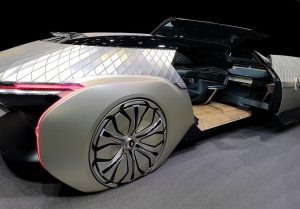
The Subtle Rise of the Self-Driving Car
 Several years back, I wrote a long-form article on self-driving technology and the road we, as an industry, would have to take to achieve fully autonomous automobiles. With the exception of a single source, who believed that his then 13-year-old daughter would serve as a passenger in her own car by the time she got her ‘driver’s license’ most of the experts were in agreement that self-driving technology, as it had been fantasized about, was a long way off in the distance. Assuming it was ever meant to be.
Several years back, I wrote a long-form article on self-driving technology and the road we, as an industry, would have to take to achieve fully autonomous automobiles. With the exception of a single source, who believed that his then 13-year-old daughter would serve as a passenger in her own car by the time she got her ‘driver’s license’ most of the experts were in agreement that self-driving technology, as it had been fantasized about, was a long way off in the distance. Assuming it was ever meant to be.
But while we are a far ways from the Jetsons and the co-piloting your own car experience, the truth is that self-driving technology has infiltrated our cars and our lives in unique and extremely effective ways. No, you cannot sit back and watch a television program on your commute to work. Even companies like Tesla and Google are still tinkering with that technology and many would argue that it’s the most advanced on the market. But self-driving technology is an umbrella idea, one that goes far beyond the singular idea of autonomy to include safety, comfort, and reliability.
 Take the brakes in your car for instance. You don’t need a brand new car to rely on ABS or anti-lock braking system. The ABS technology has been around for nearly seventy years, preventing your brakes from locking up during a sudden stop, meaning less skidding, less hydroplaning and fewer accidents. In today’s world, you also get automatic braking, for a car and driver relationship that means twice the set of instincts and double the chance of avoiding an accident. Curve speed warning ensures you don’t enter turns too quickly and brake assist programs will provide extra power to your braking system in the event of an emergency.
Take the brakes in your car for instance. You don’t need a brand new car to rely on ABS or anti-lock braking system. The ABS technology has been around for nearly seventy years, preventing your brakes from locking up during a sudden stop, meaning less skidding, less hydroplaning and fewer accidents. In today’s world, you also get automatic braking, for a car and driver relationship that means twice the set of instincts and double the chance of avoiding an accident. Curve speed warning ensures you don’t enter turns too quickly and brake assist programs will provide extra power to your braking system in the event of an emergency.
And your chances of meeting with an emergency are lessened too, what with the myriad sensors we can expect from all modern vehicles. Not only does your car come equipped with backup cameras, but it also has warnings and sensors for pedestrian, bike and obstacle detection, collision prevention and lane departure. You can even rely on adaptive cruise control, an intelligent system that knows when to brake and slow, to keep a safe distance between you and the car ahead of you. Drowsiness alert is another smart feature that can recognize when you driving indicates signs of distraction or unsafe performance and will suggest, via a small coffee icon on the dash, that you take a break from the road.
There are also the smart features that keep your car in the best shape possible. Forget about the mysterious check-engine light and its questionable effect at helping you diagnose a problem. Self-driving tech can now tell you when your tire pressure has changed, especially important in extreme temperatures, and inform you on how outside temperatures will impact road conditions and driving experience.
 At the end of the day, self-driving technology isn’t nearly as exciting as they promised us it would be. Our cars aren’t sleek, monochromatic orbs sliding along empty silver streets with rows of running lights like personalized airplane cabins. But that’s okay. Because the self-driving technology we do have goes way beyond technology for technology sake. It genuinely makes a positive impact on the way we drive, the way we communicate with our cars and the general health and safety of the vehicles we use every day.
At the end of the day, self-driving technology isn’t nearly as exciting as they promised us it would be. Our cars aren’t sleek, monochromatic orbs sliding along empty silver streets with rows of running lights like personalized airplane cabins. But that’s okay. Because the self-driving technology we do have goes way beyond technology for technology sake. It genuinely makes a positive impact on the way we drive, the way we communicate with our cars and the general health and safety of the vehicles we use every day.
The self-driving car, the flying car, it is easy to fall into the trap of wanting technological advances because we are determined to crash into the future with both tires forward. But when we explore beyond the bubbletops and the smooth-sailing eggs, we get a look at the advances our industry has already made, advances that the average driver can appreciate and rely on in their real lives. And that is so much more important. ![]()

